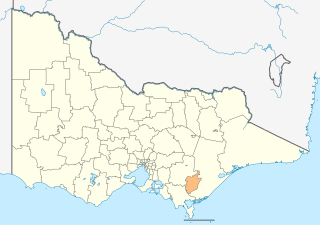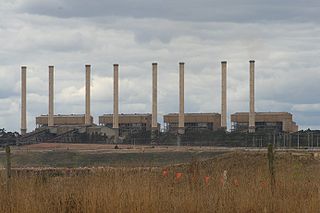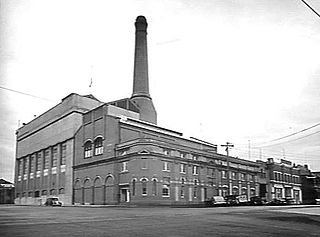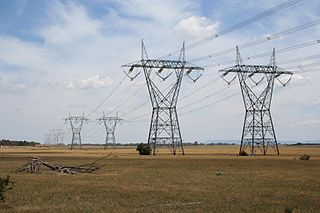
The City of Latrobe is a local government area in the Gippsland region in eastern Victoria, Australia, located in the eastern part of the state. It covers an area of 1,426 square kilometres (551 sq mi) and in June 2018 had a population of 75,211. It is primarily urban with the vast majority of its population living within the four major urban areas of Moe, Morwell, Traralgon, and Churchill, and other significant settlements in the LGA include Boolarra, Callignee, Glengarry, Jeeralang, Newborough, Toongabbie, Tyers, Yallourn North and Yinnar. It was formed in 1994 from the amalgamation of the City of Moe, City of Morwell, City of Traralgon, Shire of Traralgon, and parts of the Shire of Narracan and Shire of Rosedale. The Yallourn Works Area was added in 1996. When formed, the municipality was called the Shire of La Trobe, but on 6 April 2000, it adopted its current name.

Yallourn, Victoria was a company town in Victoria, Australia built between 1921 and 1961 to house employees of the State Electricity Commission of Victoria (SECV), who operated the nearby Yallourn Power Station complex. However, expansion of the adjacent open-cut brown coal mine led to the closure and removal of the town in the 1980s. Whilst the township no longer exists, at the 2006 census, the adjacent region classified as Yallourn had a population of 251.

Richmond Power Station was a coal fired power station which operated on the banks of the Yarra River in Richmond, Victoria, Australia from its construction in 1891 until its closure in 1976. It was one of the first alternating current (AC) electricity generation plants in the state. It has since been converted into office space and is the headquarters of international fashion brand Country Road and advertising agency CHE Proximity. The area in which it is located is now called Cremorne.

The Loy Yang Power Station is a brown coal- fired thermal power station located on the outskirts of the city of Traralgon, in south-eastern Victoria, Australia. It consists of two sections, known as Loy Yang A and Loy Yang B. Both Loy Yang A and B are supplied by the Loy Yang brown coal mine. The Loy Yang power stations are located in the brown coal rich Latrobe Valley, along with the Yallourn Power Station.

The Hazelwood Power Station was a decommissioned brown coal-fuelled thermal power station located in the Latrobe Valley of Victoria, Australia. Built between 1964 and 1971, the 1,600-megawatt-capacity power station was made up of eight 200MW units, and supplied up to 25% of Victoria's base load electricity and more than 5% of Australia's total electricity demand. It was a 'subcritical' pulverized coal-fired boiler. The station was listed as the least carbon efficient power station in the OECD in a 2005 report by WWF Australia, making it one of the most polluting power stations in the world. At 1.56 tonnes of CO2 for each megawatt hour of electricity, it was 50% more polluting than the average black coal power station in New South Wales or Queensland. Hazelwood emitted 14% of Victoria's annual greenhouse gas emissions and 3% of Australia's greenhouse gas emissions.
EnergyAustralia is an electricity generation, electricity and gas retailing private company in Australia. It is one of the "big three" retailers in the National Electricity Market. It generates electricity primarily using coal fired generation, at the Yallourn Power Station in Victoria, and the Mount Piper Power Station in New South Wales. 10% of its generation is from wind power, 32% from gas, and 58% from coal. It is Australia's second biggest emitter of greenhouse gases, after AGL Energy. As a loss making company in 2023, its parent in Hong Kong, CLP Group, has stated that it is looking for partners for renewable energy investment, however as of this time, there were no plans to build new renewable energy itself.

The Yallourn Power Station, now owned by EnergyAustralia a wholly owned subsidiary of the Hong-Kong-based CLP Group, is located in the Latrobe Valley of Victoria, Australia, beside the Latrobe River, with the company town of Yallourn located to the south west. Yallourn PS was a complex of six brown coal–fired thermal power stations built progressively from the 1920s to the 1960s; all except one have now been decommissioned. Today, only the 1,450 megawatts (1,940,000 hp) Yallourn W plant remains. It is the second largest power station in Victoria, supplying 22% of Victoria's electricity and 8% of the National Electricity Market. The adjacent open cut brown coal mine is the largest open cut coal mine in Australia, with reserves sufficient to meet the projected needs of the power station to 2028. On 10 March 2021, EnergyAustralia announced that it will close the Yallourn Power Station in mid-2028, four years ahead of schedule, and instead build a 350 megawatt battery in the Latrobe Valley by the end of 2026. At the time, Yallourn produced about 20% of Victoria's electricity.

The Kiewa Hydroelectric Scheme is the largest hydro-electric scheme in the Australian state of Victoria and the second-largest in mainland Australia after the Snowy Mountains Scheme. The scheme is situated in the Australian Alps in north-eastern Victoria about 350 kilometres from Melbourne and is wholly owned by AGL Energy.

The Energy Brix Power Station was a brown coal–fired thermal power station located at Morwell, in Victoria, Australia. The power station was used to supply electricity for the retail market, as well as the production of briquettes in the adjacent Energy Brix briquette works. It was shut down in August 2014 and is currently the earliest surviving large-scale power station designed to provide electricity to the state electricity network.

The Rubicon Hydroelectric Scheme is a small run-of-the-river hydroelectric scheme located on the Rubicon and Royston Rivers, north east of Melbourne, 40 km (25 mi) south-west of Alexandra, Victoria, Australia. The scheme commenced in 1922, and was the first state-owned hydroelectric scheme to generate electricity in mainland Australia, and among the first in the world to be remotely controlled. For the first ten years of its operation it supplied on average 16.9% of electricity generated by the State Electricity Commission of Victoria. It is now owned and operated by AGL Energy and contributes approximately 0.02% of Victoria's energy supply.
The Gas and Fuel Corporation of Victoria (G&FC) was a government-owned monopoly supplier of household gas in Victoria, Australia. It was established in 1950 and took over two of the three main gas utilities in Melbourne – the Metropolitan Gas Company and the Brighton Gas Company. As part of the conversion to natural gas, in 1971 the corporation acquired the Geelong Gas Company, one of only two remaining private gas companies in Victoria at the time. The Ballarat Gas Company closed at the time. The G&FC was wound up in June 1995.

Yallourn North is a town in the City of Latrobe, Victoria, Australia. It is approximately eight kilometres north-east of Moe, and 146 kilometres south-east of Melbourne. Prior to 1947 Yallourn North was known as "Brown Coal Mine".

The city of Geelong, Victoria, Australia was once home to two coal-fired power stations - Geelong A and Geelong B.

The Newport Power Station was a complex of power stations located on the west bank of the Yarra River, approximately 6 km south-west of Melbourne, Victoria, Australia, in the suburb of Newport. Newport A, B, and C were coal-fired plants which operated at the site between 1919 and the 1980s, and were claimed to be the largest power station in the southern hemisphere in 1953 with 42 boilers and 14 turbo-alternators producing 327 megawatts (439,000 hp).

Energy in Victoria, Australia is generated using a number of fuels or technologies, including coal, natural gas and renewable energy sources. Brown coal, historically, was the main primary energy source for the generation of electricity in the state, accounting for about 85% of electricity generation in 2008. The amount of coal-fired power has decreased significantly with the closure in 2017 of the Hazelwood power station which supplied around 20% of Victoria's electricity, and to a lesser extent with the exit of Anglesea power station in 2015. Brown coal is one of the largest contributors to Australia's total domestic greenhouse gas emissions and a source of controversy for the country. Australia is one of the highest polluters of greenhouse gas per capita in the world.

The Yallourn 900 mm railway was a 900 mm narrow gauge railway operated by the State Electricity Commission of Victoria in the Latrobe Valley of Victoria, Australia. The railway was built for the haulage of brown coal and overburden between the Yallourn open cut mine, briquette works, and power station. The Morwell Interconnecting Railway (ICR) was later constructed, linking the Yallourn mine complex with the Hazelwood open cut, briquette works, and power station.
Two different railway lines serviced Yallourn during its existence. Both were broad gauge branches from the Gippsland line in Victoria, Australia. The first was a line branching from a junction at Hernes Oak, situated between Moe and Morwell, which was in service from 1922 to 1955. The second Yallourn railway line junctioned at Moe, and was used between 1953 and 1986.
Hyman Herman was a geologist and engineer, and was described as the 'father of Yallourn'. He was director of the Victorian Department of Mines and chair of the Government Brown Coal Advisory Committee. He was instrumental in the establishment of the Victorian State Electricity Commission taking a role as engineer for brown coal.



















